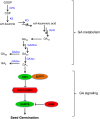Molecular Mechanisms Underlying Abscisic Acid/Gibberellin Balance in the Control of Seed Dormancy and Germination in Cereals
- PMID: 29875780
- PMCID: PMC5974119
- DOI: 10.3389/fpls.2018.00668
Molecular Mechanisms Underlying Abscisic Acid/Gibberellin Balance in the Control of Seed Dormancy and Germination in Cereals
Abstract
Seed dormancy is an adaptive trait that does not allow the germination of an intact viable seed under favorable environmental conditions. Non-dormant seeds or seeds with low level of dormancy can germinate readily under optimal environmental conditions, and such a trait leads to preharvest sprouting, germination of seeds on the mother plant prior to harvest, which significantly reduces the yield and quality of cereal crops. High level of dormancy, on the other hand, may lead to non-uniform germination and seedling establishment. Therefore, intermediate dormancy is considered to be a desirable trait as it prevents the problems of sprouting and allows uniformity of postharvest germination of seeds. Induction, maintenance, and release of seed dormancy are complex physiological processes that are influenced by a wide range of endogenous and environmental factors. Plant hormones, mainly abscisic acid (ABA) and gibberellin (GA), are the major endogenous factors that act antagonistically in the control of seed dormancy and germination; ABA positively regulates the induction and maintenance of dormancy, while GA enhances germination. Significant progress has been made in recent years in the elucidation of molecular mechanisms regulating ABA/GA balance and thereby dormancy and germination in cereal seeds, and this review summarizes the current state of knowledge on the topic.
Keywords: abscisic acid; cereals; dormancy; germination; gibberellin; plant hormones; preharvest sprouting; seed.
Figures



References
Publication types
LinkOut - more resources
Full Text Sources
Other Literature Sources

